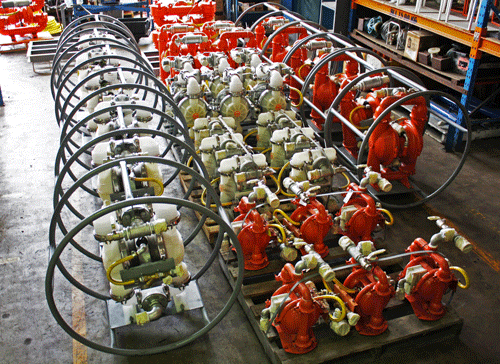
In the early days of the mining industry, operations were basic—identify the spot where the commodity might be buried, dig a hole and send people in to retrieve the commodity. For generations, this was the way it was done, though this process had its inherent drawbacks; most notably, the extreme safety risks the miners faced every second they were underground.
Today’s mining operations barely resemble those of ancient times, with sophisticated equipment and systems making the identification of lodes—deposits of metalliferous ore that fill or are embedded in a fissure in a rock formation—more precise, and the retrieval of the commodity more effective. But perhaps the most important advance in mining operations is the increased determination to make the operation as safe as possible for the miner, the communities in which the mines operate and the environment.
Over the decades, targeted steps have been taken to improve the safety of mine personnel, as well as the people who live in nearby communities. That dedication has paid off, for example, in the United States, where, in early 2019, the Mine Safety and Health Administration (MSHA) reported the fatality rate in U.S. mines was the second-lowest ever in 2018, based on the number of hours that were worked during the year. Additionally, the MSHA reported that actual work-related fatalities in mines totaled 27 for the year, out of the approximately 330,000 miners who work in the nation’s more than 13,000 metal, nonmetal and coal mines. Those numbers have remained consistent in preceding years with 29 reported fatalities in mines in 2020 and 37 in 2021. Currently, there are 26 fatalities for the year as of Oct. 28, 2022, according to MSHA.
Mining safety is most precarious in underground mines, but advances in the ways that mines are dug—and the shafts are shored up—have helped mitigate much of the potential for cave-ins, collapses and explosions. Ensuring the safety of the mine infrastructure is just one part of the equation, however. Within those mines, many different types of equipment are used during the exploration and extraction processes. One of the most common is the industrial pump, which is used for many applications within a mining operation.
This article will demonstrate how air-operated double-diaphragm (AODD) pumps offer the operational reliability that is paramount to the success of a mining operation, as well as the safety in operation that helps prevent disasters.
The Challenge
Pumps are pushed to their limit when used in a mining operation. Nearly all mining takes place in harsh conditions, with the pumps tasked to handle a wide range of solids, abrasives and particulate-laden liquids. AODD pumps are often the choice for these unforgiving tasks because their design enables them to outperform other pump styles in many mining applications.
Within the universe of AODD pumps, however, not all are created equal. Excessive downtime can limit a mining operation to the point where production delays can have an adverse effect on the mine’s cost-effectiveness. This requires an AODD pump that can reliably meet the needs of demanding mining operations.
Too often, manufacturers do not take the time to create a pump that can stand up to the rigors of the mining site. This can result in complete failure when used in an unsuitable application. This not only delays production, but also puts personnel at risk of injury or death. Pumps that are less durable are also likely to require more basic maintenance, which will also result in increased downtime and added ancillary costs for the mining company.
Many AODD pump models struggle to deliver the discharge pressures and flow rates that are required for severe-duty pumping in a mining operation, hampering production rates and increasing the risk of pump breakdown, as well as the potential for a catastrophic failure that can lead to increased safety risks.
The Solution
AODD pump technology, though, can excel in severe-duty mining applications so long as it is effectively designed and operated for the challenges that occur underground. When it comes to tasks within a mine, AODD pumps have an extensive list of potential operations, including:
- froth flotation for particulate separation in slurries
- leaching of commodity by-products
- transfer and treatment of mine tailings
- wash bays for large-scale machinery and vehicles
- above and below-ground dewatering
- bulk liquid chemical transfer
- raw material transfer
- water recirculation
- water/land reclamation
- explosive atmospheres
- oil-separation processes
- on-site bulk fuel transfer
- soap dispensing through on-site bath houses
Metal-based AODD pumps provide features mining professionals can trust in terms of safety and functionality. Some essential features found in certain metal-based AODD pumps are a shock-absorbing polyurethane screen base that absorbs the impact from the constant assault by solid particles and increased internal clearances to prevent aggregate entrapment, resulting in maximized durability. These pumps can also feature an integrated suction strainer, with the option of plumbed suction, if needed.
An enhancement for these pumps is an air distribution system, designed with an air control spool to reduce air-consumption by up to 60% (see Sidebar). Typical AODD pump sizes for these applications range from 38 millimeters (mm) (1.5 inches [in.]) to 76 mm (3 in.), constructed either with aluminum or ductile iron.
That composition for an AODD pump can also make it submersible, intrinsically safe, lube-free, able to run dry, have anti-freezing properties and the ability to handle pressures up to 125 pounds per square inch (psi) (8.6 bar). Depending on the pump model, flow rates can range from 81 to 205 gallons per minute (gpm).
The operating conditions at most mines around the world are trying. Certain AODD pumps help make mining conditions safer for site personnel and the environment. AODD pumps not only allow mining companies to meet their production goals, but do it in the safest, most employee-friendly manner possible.

